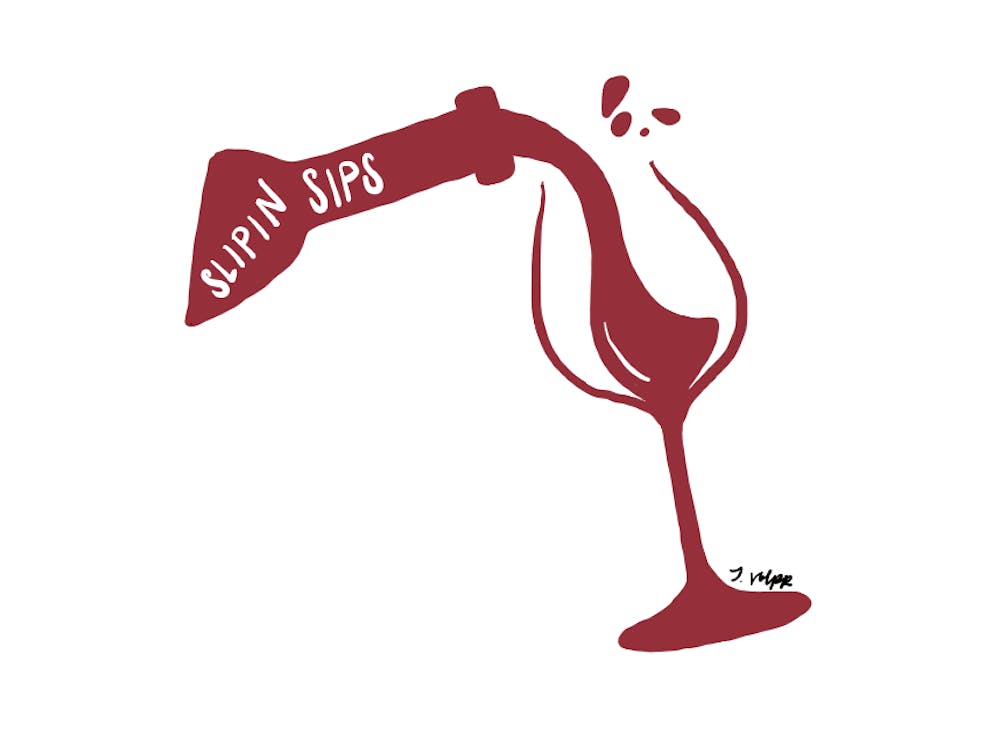“Slipin Sips” is a wine column written by Staff Writer Sam Lipin (hence the title, “Slipin”). As an amateur sommelier, Sam exists deep in the world of wine, particularly natural wine, and this column seeks to share the joy he finds in fermented grapes with the rest of the world.
After serving wine to a plethora of thirsty 60-year-old folks this weekend at Schmetterling Wine Shop’s second-to-last Saturday before their closing on Oct. 7, I got to thinking more about the history of organic agriculture in both the new and old wine worlds. Although it is still no easy task to explain to younger folk the importance of natural wine — transitioning to organic practices in the field while omitting the use of any B.S. in the cellar — they generally can better appreciate the importance of transitioning away from the use of harmful chemical herbicides and pesticides (I mean, have you ever been to the Middlebury Natural Foods Co-Op?). The older generation unfortunately grew up in a food market where the sacks and bushels were saturated with synthetic fertilizers, pesticides and herbicides. I explained to them that the natural wine movement runs concurrently with what some might consider the next agricultural revolution.
The Green Revolution, which took place following World War II, transformed agriculture around the world to feed the millions of hungry mouths made hungrier by the devastation caused by the war. The movement’s primary goal was to increase crop yield worldwide. This was accomplished through the eradication of polyculture, or the growing of multiple types of crops on the same field, and its replacement with industrial monoculture, the growing of one type of crop per field. With this shift came the invention and subsequent use of chemicals that kill the harmful bacteria and fungi that inhibit production. It solved the short-term issue — food became available in bulk, and stomachs were filled.
This movement represented the first time in agriculture’s 12,000-year history that synthetic chemicals had been used to treat the soil. And boy did they take over. What began as a well-intentioned effort to feed the planet became a major source of profit for industrial chemical companies around the world. Companies like BASF, Bayer, Dow and Montsanto peddled their products to farmers around the world, all while omitting three important factors from their sales pitch: their soil would suffer long-term erosion and eventual death, the nutritional quality of the crop itself would diminish drastically and continued exposure to these agrochemicals would double the users’ risk of cancer.
In his book “Cultural Insurrection: A Manifesto for the Arts, Agriculture, and Natural Wine,” filmmaker, author and farmer Jonathan Nossiter argues that the Green Revolution should be renamed the “Black Revolution” or the “New Black Death.”
“The ubiquitous use of synthetic chemicals in the last fifty years has transformed wine and most foodstuffs into chimeras: chimeras in the sense of the mythological evocation of a fire-breathing she-monster (made of lion’s head, goat’s body, and fabrication of the mind),” Nossiter writes.
His argument is that the products we now find filling the shelves of our local supermarket are mere concepts, lackluster imitations of the fruits and vegetables produced in the past.
The best evidence for Nossiter’s claims are the nutritional analyses of some of the most popular crops affected worldwide by the agrochemical industry. Philippe Desbrosses, a former agricultural consultant for the European Union and the French Ministry of Agriculture, concluded that today’s average apple contains a mere hundredth of the vitamin C stored in the same fruit from 1950.
“When our grandparents, as children, bit into a Granny Smith, they swallowed 400 mg of vitamin C, indispensable for the growth and maintenance of bones and skin. Today, supermarket aisles are filled with standardized clones that average 4 mg of vitamin C each,” Desbrosses writes.
Let’s return to the focus of this column: the importance of natural wine. This goes beyond the alcoholic juice in your glass. The aforementioned Green Revolution left no field untouched, least among them vineyards. Whether it is your $5 jug of Yellowtail or the $1,000 bottle of Bordeaux Grand Cru, grapes and the wine they produce failed to escape the catastrophe imposed by the agrochemical revolution. I can only dream of what wine tasted like prior to the 20th century.
But thankfully, it is not all doom and gloom. Farms and vineyards around the world have realized their soils will be lifeless, bereft of the necessary organisms and bacteria needed for plant growth and production. Herein is the chief purpose of the natural wine movement. Forget what you have heard about it — that it’s an attempt to bring flawed, funky, fecal-scented ferments to a hipster wine-drinking crowd. A natural wine producer’s goal is to reinvigorate the soil that at one point in time was littered with the same chemicals used in mustard gas during both World Wars. It is to welcome back the microbiomes and bacteria that are necessary for the success of any crop and the happiness of any farm and to denormalize the use of these poisonous materials in place of organic defense mechanisms.
That is why it might be worth it to spend an extra $10 on a bottle of wine. Because these farmers are rejecting chemical viticulture, they must tend to their farms themselves and not rely on synthetic solutions. Their product is a labor of love, an ode to Mother Earth and a request for a second chance.

Sam Lipin '23.5 returns this fall for his third semester as an editor for the Sports section. A Classics major with an Italian minor, Sam worked as a reporting intern this summer at the Addison Independent. He has hosted four radio shows through WRMC and tells his friends he plays rugby though he has not been to a practice in a year and a half.




